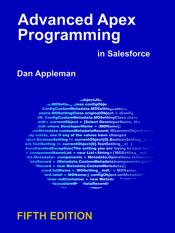There are a lot a lot of coders who write Apex. There are fewer designers and even fewer architects. It’s important to understand the difference between them.
Most beginners start out by learning to program – to write code. That’s how I started out. You have a task in mind and you need to find a way to implement a solution in software. In many cases you don’t even need to understand the solution – you can just use Google to find how someone else solved the problem and copy and paste the code. That’s ok too – it’s how we learn.
For a long time this was all you needed to survive as an Apex programmer. The truth was, Apex was mostly used as a “scripting” language – a tool to perform some limited tasks that weren’t quite possible using workflows, formulas and similar tools. And in this context, an “advanced” programmer is one who knows how to implement a wide variety of these tasks – and who understands how and why they work.
But Force.com has changed over the past few years. The language has grown in sophistication. The platform API has grown enormously. Some critical limits have been relaxed. The platform now supports more complex scenarios – not just simple scripts, but large applications. Some of these applications just evolve – organizations may start with a few triggers and web service calls, but these accumulate until the interactions between the various elements start interfering with each other and the whole thing becomes costly and difficult to maintain. But other applications are designed – and can avoid those problems.
There are two great truths about software that every programmer needs to know:
- Writing code is only a small portion of the life-cycle cost of software.
- The least expensive time to resolve software issues is during the design phase.
Real software and real applications – which is what you can now write in Apex on Force.com, require you consider the entire software life-cycle – This includes defining requirements, designing the solution, writing the code, testing and validating, training and support, and maintenance. That’s the real difference between a coder and an architect. Most coders focus on writing the code. Architects and designers care about the entire lifecycle. If you get your design right, the costs of software over the entire life-cycle drops, and the odds of a project succeeding increase dramatically.
I recently saw a post by an individual asking if this book contained some advanced coding techniques relating to JSON authentication and OAuth. It does not. Why? Because coding techniques and solutions to specific coding problems don’t belong in books anymore – that’s what you use Google and forums for.
This book is intended to help Apex developers to think in terms of design and architecture – to understand design patterns and the consequences of design choices. Yes, there’s plenty of code in the book, but instead of seeing one way to do five different things, you’re much more likely to see five ways to do the same thing – and how and why you might choose each one.
That’s what makes this an advanced book – because it’s not about writing code, it’s about programming. It’s not about learning to solve one specific technical problem, but how to learn to solve any problem you run into. It’s about learning to design code so you anticipate problems and thus never actually run into them at all.
The book doesn’t contain everything a Force.com developer needs to know – no book could. But I do believe that every serious Force.com developer needs to know what’s in this book.

